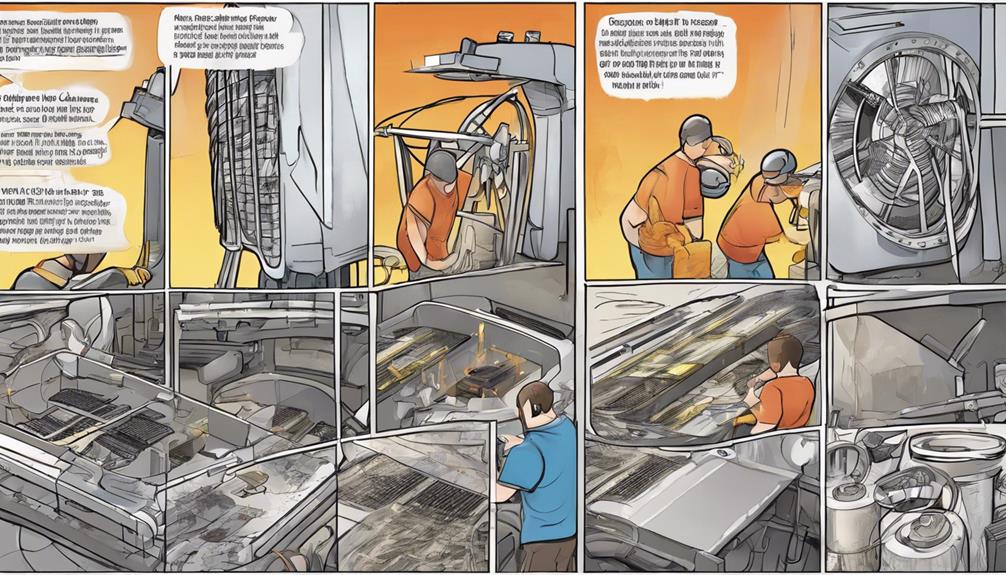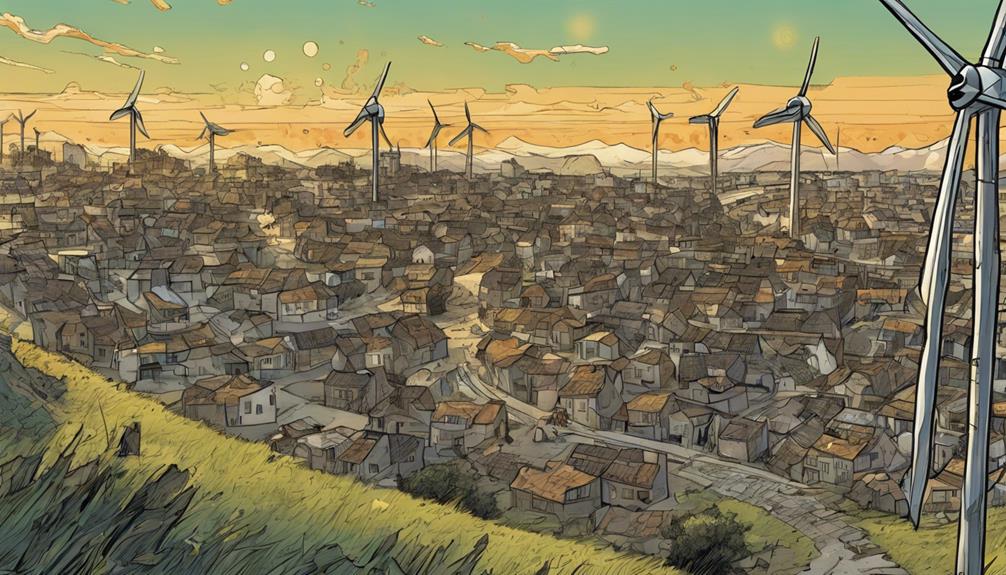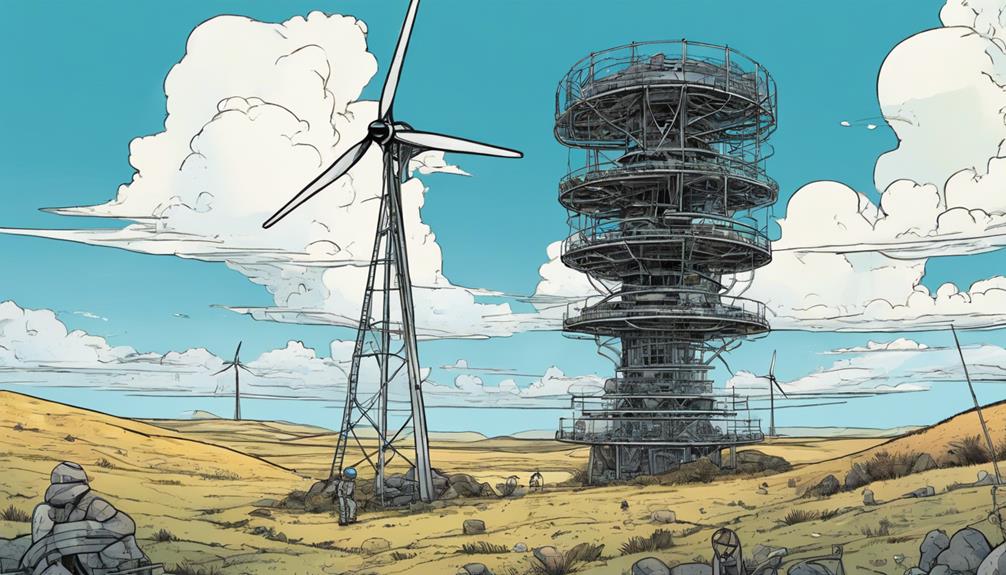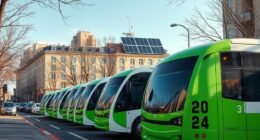Wind energy is crucial for the power grid, ensuring stability and sustainability. By integrating renewable sources like wind, carbon emissions are reduced. Wind turbines convert wind into electrical power, feeding it into the grid seamlessly. Advanced management strategies handle variability for stability. Wind power not only balances the grid but also optimizes clean energy usage. Challenges include supply-demand balance, but strategic planning and storage systems help. If you want to know more about wind energy's impact on the grid, keep exploring the benefits, challenges, and solutions in this domain.
Key Takeaways
- Wind energy enhances grid stability through advanced management strategies.
- Wind power integration optimizes renewable energy usage for a sustainable grid.
- Wind turbines contribute over 10% of U.S. energy and reduce CO2 emissions.
- Wind projects inject billions into the economy and create numerous jobs.
- Coordination between wind farm and grid operators ensures efficient wind power transmission.
Wind Energy Importance
Diversifying energy sources and reducing carbon emissions, wind energy holds a crucial role in the power grid. Through renewable energy integration, wind energy generation greatly contributes to the grid connection, providing a sustainable and low-cost alternative for electricity production.
In the U.S., wind energy has become a cornerstone in the effort to shift towards cleaner energy sources, with wind turbines playing a vital role in meeting energy demands while mitigating environmental impacts.
Wind projects not only support the economy by adding $20 billion annually but also have the potential to create hundreds of thousands of jobs by 2050. The wind industry's growth has been substantial, with over 125,000 jobs supported, including the rapid increase in wind turbine service technicians.
Wind turbines operating across all 50 states have collectively prevented 336 million metric tons of CO2 emissions per year, showcasing the significant impact of wind energy on reducing greenhouse gas emissions and combating climate change.
Wind Turbine Mechanics

Let's talk about the intricate mechanics of wind turbines.
The design of turbine blades is a crucial aspect to consider.
The function of the generator is another key component in the process.
The transmission of electrical energy is a vital part of the system.
Understanding these components is essential in grasping how wind energy is efficiently harnessed and converted into electricity.
Turbine Blade Design
Maximizing wind energy capture efficiency in wind turbines relies heavily on the design of the turbine blades. Blade length plays a pivotal role in determining the power output and overall performance of wind turbines.
Modern turbine blades have pushed the limits, exceeding lengths of over 80 meters to harness more wind energy effectively. The use of advanced aerodynamic profiles and materials has become essential in optimizing blade design for higher energy production. These innovations not only improve energy efficiency but also contribute to reducing noise levels associated with wind turbine operations.
Additionally, innovative blade designs such as curved or twisted blades have been implemented to enhance wind turbine performance further. By constantly refining turbine blade design with cutting-edge technologies and materials, the wind energy industry continues to advance towards greater efficiency and sustainability in power generation.
Generator and Transmission
Wind energy harnessed by turbine blades is converted into electrical energy by the generator within the nacelle, facilitating its transmission through the grid for widespread distribution.
The generator housed in the nacelle transforms the kinetic energy from the spinning turbine blades into electrical power. Once generated, this electricity is then passed through transformers to increase its voltage for efficient transmission over long distances.
Wind power, in the form of electricity, is seamlessly integrated into the national grid, allowing for the distribution of clean and sustainable energy to homes and businesses.
The mechanics of wind turbines play an essential role in harnessing wind power and converting it into a usable form of energy that can be easily transmitted and utilized across the power grid. This process ensures that wind energy contributes significantly to the overall electricity supply in a reliable and environmentally friendly manner.
Wind Power Integration

Integrating wind power into the grid requires enhancing stability and optimizing renewable energy usage. Operators manage the variability of wind energy to guarantee grid reliability and efficiency.
Upgrading transmission systems is crucial to accommodate the increasing capacity of wind power.
Grid Stability Enhancements
Enhancing grid stability through the integration of wind power involves implementing advanced management strategies to manage the variability of wind energy production effectively.
Wind power integration plays a vital role in enhancing grid stability by offering a reliable and sustainable electricity source. To guarantee stability, grid operators utilize various techniques such as frequency regulation and voltage control.
Wind farms contribute significantly to grid stability by providing ancillary services like reactive power support. The integration of wind power into the grid necessitates close coordination between wind farm operators and grid operators to maintain stability levels.
Renewable Energy Optimization
Efficiently optimizing renewable energy usage in the power grid often involves harnessing the abundance of wind resources through advanced control strategies and energy storage systems. Wind power integration plays a pivotal role in balancing the grid and increasing the share of clean energy sources. Here are key aspects of renewable energy optimization in wind power integration:
- Advanced Control Strategies:
Implementing sophisticated control mechanisms allows for better management of variable wind energy output, ensuring seamless integration into the power grid.
- Energy Storage Systems:
Utilizing energy storage technologies such as batteries or pumped hydro storage helps store excess wind energy for times of high demand or low wind availability, enhancing grid reliability.
- Grid-Friendly Designs:
Developing wind energy conversion systems with grid-friendly features facilitates smooth integration and minimizes disruptions to the power grid, promoting stability and efficiency.
Wind Energy Advantages

With numerous benefits, wind energy presents a compelling case for its widespread adoption in the power grid. As one of the key renewable energy sources, wind power plants play an important role in diversifying the energy mix and reducing reliance on fossil fuels. The integration of wind energy into the grid has led to significant advancements in sustainable energy production.
Wind energy not only contributes to environmental conservation but also drives economic growth. Investments in new wind projects have injected $20 billion into the U.S. economy in 2022 alone. Additionally, wind turbines across all states have collectively generated over 10% of the nation's energy, aiding in the avoidance of 336 million metric tons of CO2 emissions annually.
Beyond economic benefits, wind projects also bring about substantial social advantages. They support over 125,000 jobs in the U.S. and have the potential to create hundreds of thousands more by 2050, benefiting local communities through tax payments and land-lease agreements.
Wind Energy Challenges

Overcoming challenges in integrating wind energy into the power grid requires innovative solutions and strategic planning. The intermittent nature of wind sources poses hurdles that impact grid management, electricity quality, and present technical obstacles.
To address these challenges, consider the following:
- Grid Management: The variability of wind energy production necessitates refined grid management strategies to balance supply and demand effectively.
- Electricity Quality: Fluctuations in wind energy output can affect the stability and quality of electricity delivered to consumers, highlighting the need for improved quality control measures.
- Technical Obstacles: Grid stability and power quality issues arising from integrating wind energy call for advanced control strategies, energy storage systems, and grid-friendly designs to mitigate these technical challenges.
Grid Impact Solutions

You should consider advanced control strategies and energy storage systems as key solutions for addressing integration challenges in wind energy.
Adhering to grid codes is vital for seamless integration and mitigating power quality issues.
Grid Stability Solutions
Grid stability solutions play an essential role in ensuring the seamless integration of wind energy into the power grid.
To address power quality issues and maintain grid stability, consider the following:
- Advanced Control Strategies: Implementing advanced control strategies in wind energy conversion systems (WECS) helps regulate the power output and enhance grid stability by adjusting to grid conditions swiftly.
- Energy Storage Systems: Integrating energy storage systems with WECS allows for storing excess energy during low demand periods and releasing it during peak demand, balancing the grid and supporting stability.
- Compliance with Grid Codes: Ensuring that WECS comply with grid codes is imperative for seamless integration. Adherence to these codes guarantees that the system operates within specified limits, contributing to grid stability and power quality.
Integration Challenges Addressed
Addressing the impact of wind energy integration on the grid involves implementing innovative solutions to overcome challenges related to intermittent supply and power quality.
Grid integration of wind energy poses unique challenges due to its variability. To tackle these issues, advanced control strategies, energy storage systems, and grid-friendly designs are important.
Voltage fluctuations, harmonics, and grid instability are common power quality issues that can affect the seamless integration of wind energy conversion systems (WECS). Compliance with grid codes is necessary for WECS to ensure grid stability and reliable operation.
Collaborative efforts between WECS operators and grid operators play an important role in successfully integrating wind energy into the power grid. By adopting these grid impact solutions, the integration of wind energy can be optimized, enhancing the overall performance and reliability of the power grid.
Renewables Interconnection

Connecting renewables like wind energy to the power grid is important for optimizing their potential benefits. Grid interconnection plays an essential role in efficiently integrating wind power into the existing electricity infrastructure.
Here are three key points to keep in mind when it comes to renewables interconnection:
- Efficient Integration: Grid interconnection allows for the seamless integration of wind energy into the power grid, ensuring that the electricity generated can be transmitted and utilized effectively.
- Reliable Transmission: Proper grid interconnection is crucial for ensuring the reliable and stable transmission of wind energy to meet electricity demand, enhancing the overall resilience of the power grid.
- Diverse Energy Mix: Integrated renewables, including wind energy, contribute to a more diverse and sustainable energy mix. This reduces reliance on fossil fuels, leading to a greener and more environmentally friendly energy sector.
Effective renewables interconnection is dependent on advanced grid management strategies that can effectively balance the supply and demand fluctuations inherent in renewable energy sources.
Transmission Infrastructure Development

Developing transmission infrastructure plays an important role in efficiently integrating wind energy into the power grid. The transmission network forms the backbone of grid infrastructure, enabling the smooth flow of electricity generated from wind farms to reach consumers.
Strategic planning for interregional and international transmission is pivotal to support the integration of wind energy, ensuring that power generated in one region can be transmitted to areas with high demand. Upgrading transmission networks enhances grid flexibility and capacity, allowing for the seamless accommodation of fluctuating wind energy production.
Coordination among stakeholders is key in maximizing the benefits of wind power integration through improved grid infrastructure. Efficient grid planning plays a significant role in optimizing the integration of wind energy, ensuring reliable and sustainable electricity supply.
Wind Energy Evolution

The development of wind energy integration has greatly impacted the renewable energy landscape, particularly with the establishment of the Energy Systems Integration Group (ESIG) as a key platform for fostering discussions on wind power.
ESIG focuses on providing technical support for incorporating renewable energy sources like wind power into power systems. This support has been instrumental in advancing the smooth integration of wind energy into the grid.
The studies conducted by ESIG and organizations like NREL have quantified the costs and benefits associated with strengthening interconnections to accommodate the increasing capacity of wind energy. These efforts haven't only facilitated the mainstream acceptance of wind power but have also highlighted its importance in enhancing grid resilience, reducing carbon emissions, and promoting the growth of wind energy as a significant energy source.
As a result, wind energy has emerged as a key player in the shift towards a more sustainable and diversified power system.
Wind Energy Benefits

Wind energy's benefits extend far beyond just providing electricity, encompassing significant contributions to environmental sustainability, economic growth, and job creation. As a renewable energy source, wind power plays a pivotal role in reducing carbon dioxide emissions by avoiding 336 million metric tons annually. This environmental impact is essential for combating climate change and promoting a cleaner energy future.
Additionally, the wind industry's economic significance is evident through its $2 billion contributions in state and local tax payments and land-lease payments yearly, boosting local economies. With wind turbines operating in all 50 states and generating over 10% of the U.S. energy supply in 2022, wind energy showcases its widespread impact on the power grid and its potential to drive economic growth.
Investments in new wind projects have added $20 billion to the U.S. economy in 2022, emphasizing the economic benefits and job creation potential of wind energy, which has the capacity to support hundreds of thousands more jobs by 2050.
Frequently Asked Questions
How Is Wind Energy Connected to the Grid?
Wind energy is connected to the grid through power lines, transmitting electricity efficiently from turbines to homes. Grid operators balance supply and demand, ensuring stability. Smart grids optimize wind energy integration, enabling reliable electricity delivery.
What Is the Impact of a Wind Power Plant on a Grid?
Like a gentle breeze shaping a field, a wind power plant can delicately influence a grid. It bolsters sustainability, curbs emissions, and enhances resilience. Embrace the potential, but navigate the fluctuations with strategic planning.
What Are the Benefits of Wind Energy to the Power System?
Wind energy benefits the power system by providing reliable, sustainable electricity, reducing emissions, and supporting grid stability. It offers cost-effective generation, diversifies the energy mix, and enhances resilience, contributing to a cleaner energy system.
How Is Wind Energy Used in Power Generation?
You use wind energy in power generation by harnessing wind kinetic energy with turbines. These turbines convert the energy into electricity that gets distributed through the grid for homes, businesses, and private use, supporting sustainability and reducing emissions.
What Are the Advantages of Wind Energy in Comparison to Solar Energy in the Power Grid?
When comparing solar vs. wind: efficiency and benefits in the power grid, wind energy offers several advantages. Wind turbines can generate electricity even at night, while solar panels cannot. Additionally, wind energy can be more cost-effective and has a more consistent power output compared to solar energy, making it a reliable source of renewable energy.
What are the benefits and efficiency of incorporating wind energy into the power grid compared to solar energy?
When it comes to the solar vs wind comparison efficiency, both sources have their advantages. Wind energy can be more efficient in areas with consistent wind patterns, providing a reliable source of power. Additionally, wind power has a smaller footprint, making it easier to implement in various locations compared to solar energy.
Conclusion
As the winds of change continue to blow, wind energy stands tall as an important player in the power grid. Its sleek turbines harness the power of nature, bringing clean, renewable energy to the forefront.
Despite the challenges it faces, wind energy shines bright like a beacon of hope for a sustainable future. Embrace the wind's whispers and let its energy guide us towards a greener tomorrow.










